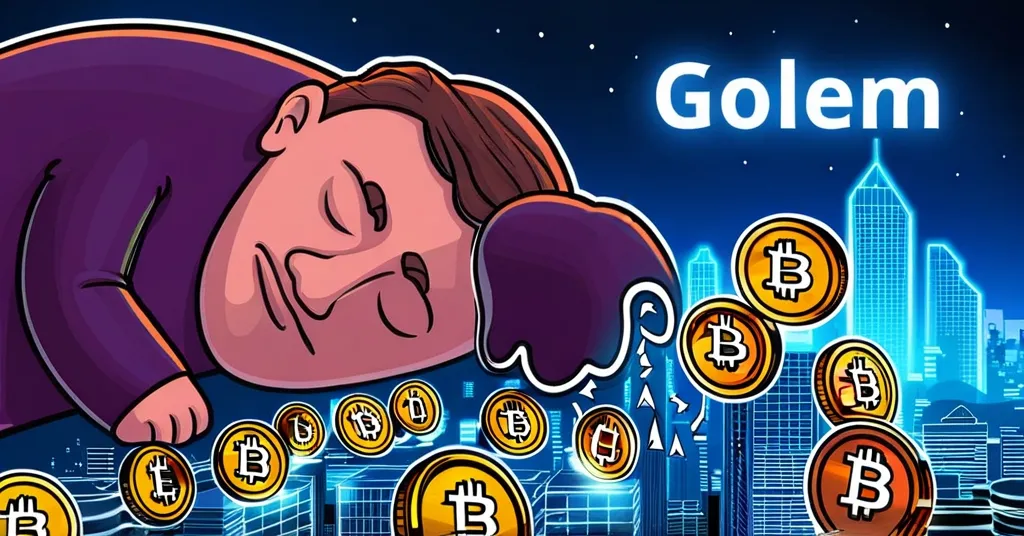Golem Transfers 7,250 ETH to Exchanges, Stirs Market: What’s Next?

Golem’s Ethereum Wallets Spring to Life, Stirring Market Speculation
Golem, a veteran of the 2016 ICO era, has recently moved significant amounts of Ethereum (ETH) to major exchanges, signaling a new chapter for the project and potentially impacting the broader crypto market.
- Golem raised 820,000 ETH in 2016 ICO
- Recent transfer of 7,250 ETH to exchanges
- Staking over 98,000 ETH for rewards
- GLM token valued at $313M market cap
Golem’s mission is to democratize computing power through a decentralized network, which they liken to Airbnb for computing resources. During its Initial Coin Offering (ICO) back in 2016, Golem raised a staggering 820,000 ETH, capitalizing on the crypto world’s fervor for blockchain technology’s potential to disrupt industries. An ICO, for those new to the scene, is essentially a crowdfunding campaign using cryptocurrency, where investors buy tokens with the promise of future utility or profit.
Fast forward to today, and Golem has stirred the crypto pot by transferring 7,250 ETH to intermediary addresses, with 4,850 ETH subsequently making its way to exchanges like Binance and Coinbase. This isn’t just Golem dusting off its old wallets; it’s shaking up the crypto dance floor. These moves suggest Golem isn’t content to rest on its laurels but is actively managing its substantial reserves.
But what’s behind this sudden activity? Golem retains over 98,000 ETH for staking on Ethereum’s Beacon Chain. Staking, in simple terms, is like locking up your ETH to help secure the Ethereum network, and in return, you earn rewards. Golem’s staking could potentially net them up to 3,872 ETH in annual rewards, providing a steady income stream while supporting the Ethereum ecosystem. However, this isn’t all sunshine and rainbows; the movement of large ETH reserves by old ICOs like Golem can exert pressure on ETH’s market price, adding to the volatility that keeps crypto enthusiasts on their toes.
Golem isn’t just about making money, though. The project has set aside 40,000 ETH for innovation scholarships and supporting other projects, embodying the ethos of decentralization and community growth. This echoes the strategies of other notable ICOs like Animoca Brands, which also use their funds to bolster the broader crypto ecosystem. It’s a reminder that in the world of crypto, it’s not just about personal gain but also about fostering innovation and growth.
Despite its active management of ETH, Golem’s native token, GLM, remains somewhat in the shadows compared to newer cryptocurrencies. With a current market cap of $313 million and trading at $0.31, GLM has around 20,000 holders and is listed on top exchanges. During the altcoin rally in March 2024, GLM reached a peak of $0.72, showcasing its potential for speculative trading. However, it ranks in the top 20 of decentralized physical infrastructure networks (DePIN), a niche but growing category that includes more popular tokens like RNDR and TAO. DePIN, by the way, refers to decentralized networks that provide physical infrastructure services, like computing power or data storage.
Golem’s recent activities highlight a strategic approach to managing its ICO funds, balancing the need for liquidity with the desire to grow its ecosystem. While the crypto world often focuses on the latest and greatest, projects like Golem remind us of the importance of long-term vision and responsible asset management. But let’s not get too starry-eyed; the crypto space is no stranger to volatility, and Golem’s movements are a reminder of the delicate dance between old ICOs and market dynamics. No bullshit, Golem’s moves could shake the ETH market like a bull in a china shop.
While Golem’s approach is commendable, it’s crucial for investors to approach with caution. The crypto market thrives on speculation, and while GLM’s long-term price predictions are optimistic, reaching up to $18.34 by 2030, these forecasts are inherently speculative and subject to the whims of the market. Always conduct your own research and manage your risks wisely.
As we watch Golem navigate its path, it’s a reminder that in the world of crypto, even the oldest projects can still surprise us. And while we champion the ideals of decentralization and freedom, it’s essential to stay grounded in reality, understanding both the potential and the pitfalls of this financial revolution.
Key Takeaways and Questions
-
What is Golem’s primary purpose?
Golem aims to develop decentralized computing solutions, allowing users to share computational resources.
-
How has Golem been managing its Ethereum reserves?
Golem has been staking a significant portion of its ETH, retaining over 98,000 ETH for this purpose, and recently moved 7,250 ETH to exchanges, likely related to staking rewards.
-
What impact do Golem’s Ethereum transactions have on the market?
The movement of large amounts of ETH from old ICOs like Golem can put downward pressure on ETH’s price, adding to market volatility.
-
What is Golem doing with its ecosystem funds?
Golem has allocated 40,000 ETH for innovation scholarships and to support other projects, aiming to foster growth within the broader crypto ecosystem.
-
How is Golem’s native token, GLM, performing in the market?
GLM is currently trading at $0.31, with a market cap of $313M, and is seen as having potential for speculative trading due to its liquidity and exchange listings.
-
What category does GLM belong to, and how does it rank?
GLM falls within the DePIN (Decentralized Physical Infrastructure Networks) category and ranks in the top 20, though it lags behind more popular tokens like RNDR and TAO.
“The problem of old ICOs with big treasuries and dormant reserves of ETH is one of the big issues for the token’s price.”
“Golem has set aside 40,000 ETH for innovation scholarships and supporting other projects.”



